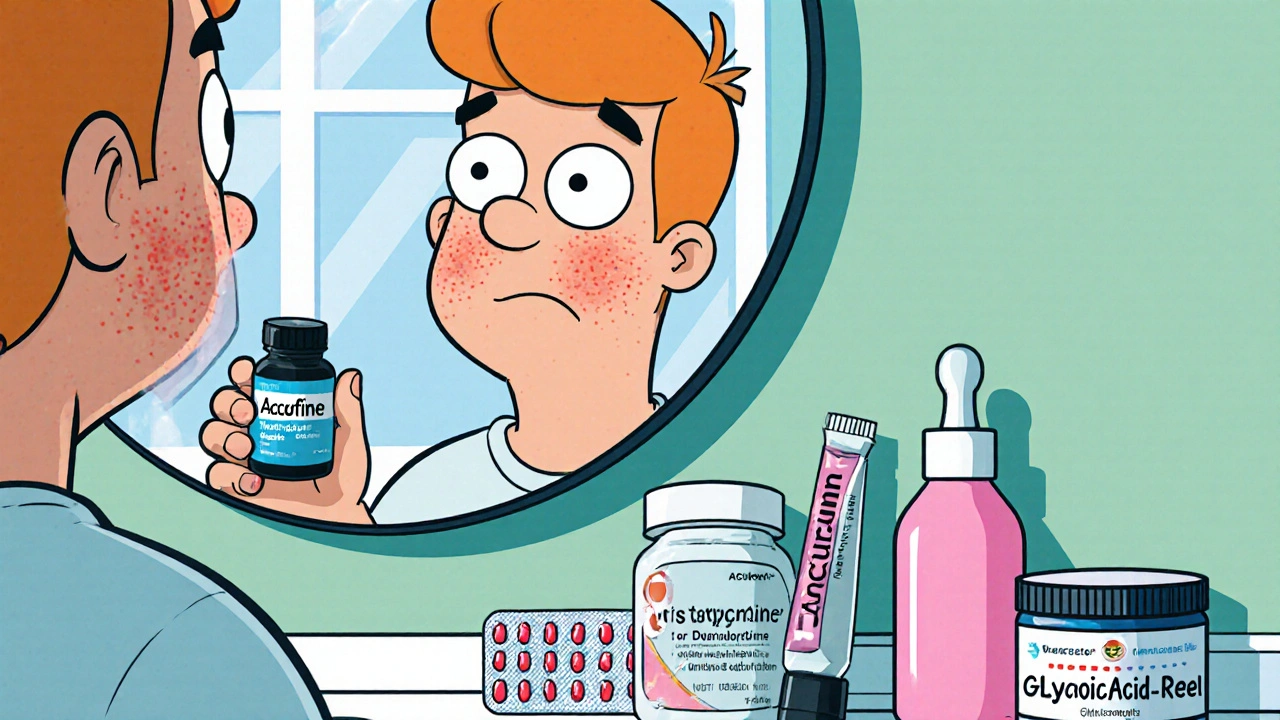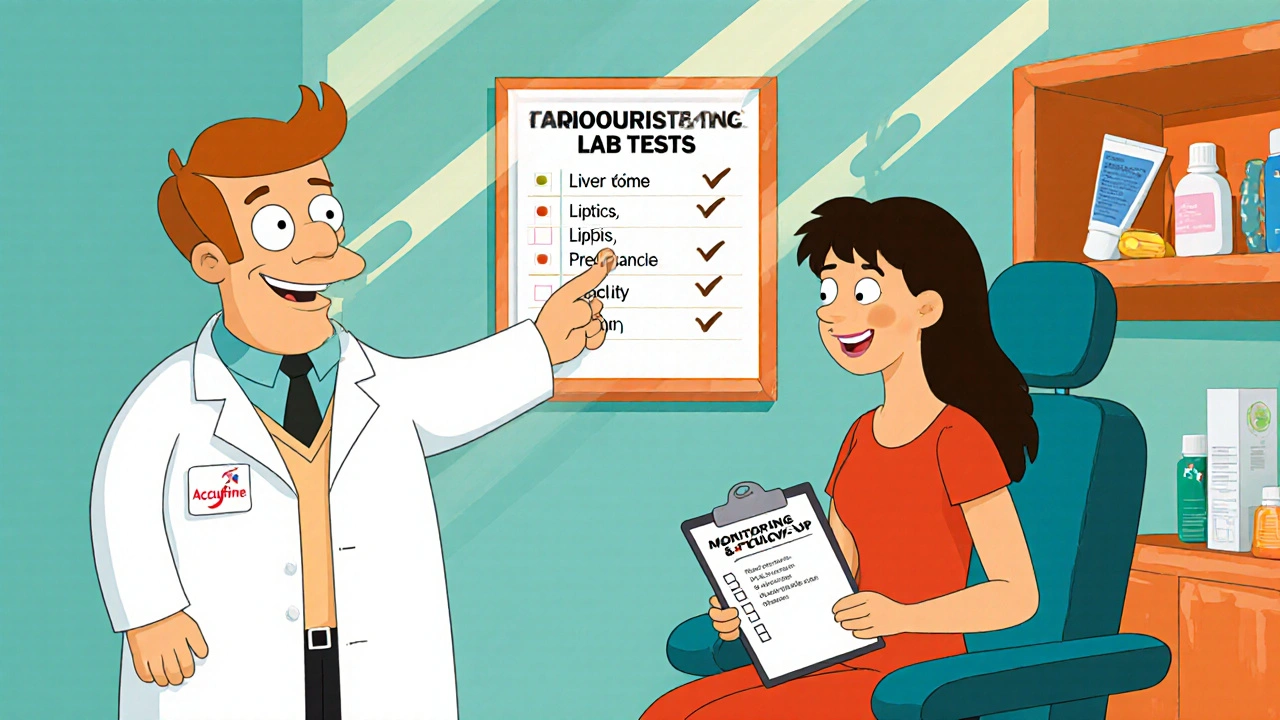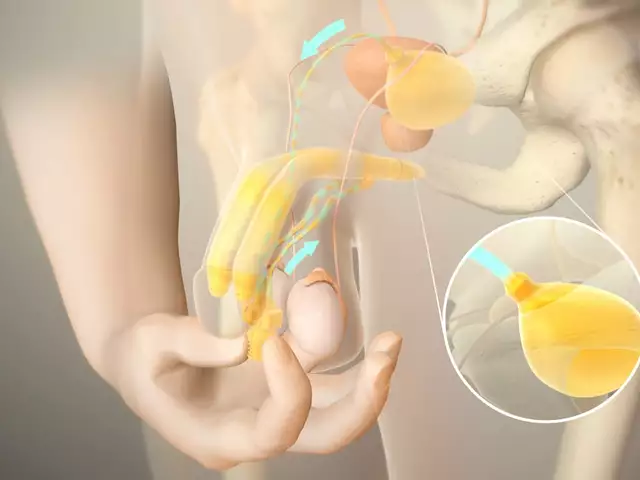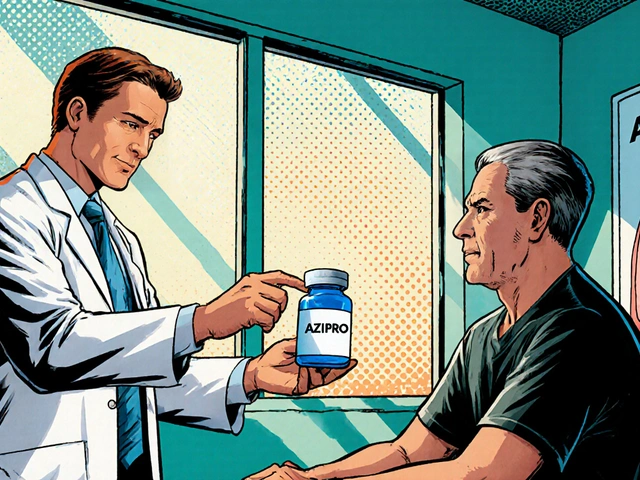
Acne Treatment Selection Guide
Which Treatment Is Right For You?
Answer these questions to get personalized recommendations for your acne treatment options.
Recommended Treatment Options
Topical Retinoids
First-LineIdeal for mild-to-moderate acne with minimal scarring risk.
Oral Antibiotics
Second-LineSuitable when inflammation is dominant.
Hormonal Therapy
For WomenEffective for hormonal acne in adult women.
Accufine (Isotretinoin)
Last ResortSevere cystic acne unresponsive to other treatments.
Quick Takeaways
- Accufine is a branded oral isotretinoin typically reserved for severe cystic acne that hasn’t responded to other meds.
- Topical retinoids (e.g., tretinoin) work on the skin surface and are first‑line for mild‑to‑moderate acne.
- Oral antibiotics such as doxycycline control inflammation but carry resistance risk.
- Hormonal therapy (spironolactone) is best for adult women with oily skin and hormonal breakouts.
- Procedural options like glycolic‑acid peels target dead‑cell buildup without systemic exposure.
When you’re staring at a list of acne meds, the biggest question is: Which one gives me clear skin with the fewest trade‑offs? This guide breaks down Accufine - a popular brand of isotretinoin - and measures it against the most common alternatives. By the end you’ll know exactly when to consider each option, what to expect during treatment, and how to minimise side effects.Accufine is a brand name for isotretinoin, a synthetic retinoid originally derived from vitamin A. It works deep inside the skin to shrink oil‑producing glands, reduce bacterial load, and normalise skin cell turnover.
How Accufine (Isotretinoin) Works
Isotretinoin targets the root causes of acne at a cellular level:
- Sebum suppression: It cuts down sebum output by up to 90%, starving the bacteria that thrive on oily skin.
- Follicle normalisation: By promoting proper keratin shedding, it prevents the plug that forms a comedo.
- Anti‑inflammatory action: Reduces the redness and swelling that make lesions painful.
- Antibacterial effect: Indirectly limits Propionibacterium acnes growth by limiting its food source.
Because it works systemically, Accufine can clear even the deepest cysts, but that same reach brings a broader side‑effect profile.
Common Alternatives to Accufine
Not every acne case needs a systemic retinoid. Below are the main categories clinicians consider before reaching for isotretinoin.
Topical Retinoids (e.g., Tretinoin, Adapalene)
Tretinoin is a prescription‑strength vitamin‑A derivative applied directly to the skin. It speeds up cell turnover and keeps pores clear. Typical strengths range from 0.025% to 0.1% cream or gel, used once nightly.
Oral Antibiotics (e.g., Doxycycline, Minocycline)
Doxycycline is a tetracycline antibiotic that reduces inflammation and bacterial growth. Dosages hover around 50‑100 mg daily for 12‑16 weeks.
Hormonal Therapy (Spironolactone, Combined Oral Contraceptives)
Spironolactone blocks androgen receptors, decreasing oil production in women. Typical dose: 50‑200 mg per day.
Benzo‑based Topicals (Benzoyl Peroxide)
Over‑the‑counter 2‑10% benzoyl peroxide gels kill acne‑causing bacteria on contact and help unclog pores.
Procedural Options (Chemical Peels, Light Therapy)
Glycolic‑acid peels (10‑30% concentration) exfoliate the outer skin layer, speeding up cell turnover without oral medication.
Side‑Effect Snapshot
Understanding risk is key to choosing the right therapy. Below is a quick visual of the most common adverse effects for each option.
| Treatment | Dry Skin | Photosensitivity | Liver Enzyme Elevation | Teratogenic Risk |
|---|---|---|---|---|
| Accufine (Isotretinoin) | High | Moderate | Common | Very High |
| Topical Tretinoin | Moderate | High | Rare | Low |
| Doxycycline | Low | Low | Rare | Low |
| Spironolactone | Low | Low | Rare | Moderate (requires contraception) |
| Glycolic Acid Peel | Low‑Moderate | High (if sun exposure after) | None | None |

Full Comparison Table
| Aspect | Accufine (Isotretinoin) | Topical Retinoids (Tretinoin, Adapalene) | Oral Antibiotics (Doxycycline) | Hormonal Therapy (Spironolactone) | Glycolic‑Acid Peel |
|---|---|---|---|---|---|
| Mechanism | Systemic retinoid - shrinks sebaceous glands, normalises keratinisation | Topical retinoid - accelerates epidermal turnover | Antibiotic - reduces bacterial load and inflammation | Androgen blocker - lowers oil production in women | Chemical exfoliation - removes dead‑cell layer |
| Typical Dosage | 0.5‑1 mg/kg daily for 4‑6 months | 0.025‑0.1 % cream/gel nightly | 50‑100 mg once daily (12‑16 weeks) | 50‑200 mg daily | 10‑30 % glycolic acid, 1‑3 sessions |
| Treatment Length | 4‑6 months (often longer for severe cases) | 3‑6 months, continued maintenance | 3‑4 months | 6‑12 months, may be indefinite with monitoring | Every 2‑4 weeks, depending on skin tolerance |
| Common Side Effects | Dry skin, cheilitis, elevated lipids, mood changes, birth defects | Dryness, irritation, photosensitivity | GI upset, photosensitivity, bacterial resistance | Hyper‑kalemia, menstrual irregularities, mild fatigue | Transient redness, peeling, possible hyperpigmentation |
| Best For | Severe nodular/cystic acne unresponsive to other therapy | Mild‑to‑moderate acne, maintenance after clearing | Inflammatory papules/pustules, especially in teens | Adult women with hormonal breakouts, especially on jawline | Patients preferring non‑systemic, quick resurfacing |
Decision‑Making Guide: When to Choose Accufine
- Severity: If you have deep, painful cysts that have lingered despite oral antibiotics and topicals, isotretinoin is often the only option that can fully clear lesions.
- Age & Pregnancy: Accufine is contraindicated in pregnancy and requires reliable contraception for women of child‑bearing potential. Teens and men without reproductive concerns are easier candidates.
- Lab Monitoring: Baseline liver enzymes, fasting lipids, and a complete blood count are mandatory. If you have chronic liver disease or uncontrolled hyperlipidaemia, alternatives are safer.
- Side‑Effect Tolerance: If you’re comfortable managing dry‑skin regimens and possibly mood monitoring, isotretinoin can be worth it. Otherwise, a topical retinoid may provide a gentler path.
Monitoring & Follow‑Up
Because isotretinoin touches many body systems, regular check‑ins are essential.
- **Baseline labs** - Liver function tests (ALT, AST), fasting lipids, and pregnancy test (if applicable).
- **Monthly labs** - Repeat the same panel to catch any rising enzymes or triglycerides.
- **Skin care regimen** - Heavy moisturisers, lip balms, and gentle, non‑comedogenic cleansers reduce dryness.
- **Mental health watch** - Document any mood swings, depression, or anxiety; refer to a psychologist if needed.
- **Dosage adjustments** - If labs climb, the doctor may reduce the dose to 0.25‑0.5 mg/kg.

Practical Tips for Every Acne Treatment
- Never mix isotretinoin with vitamin A supplements - it spikes toxicity.
- Use sunscreen SPF 30+ daily; retinoids increase photosensitivity.
- Start with a low dose of oral antibiotics to gauge tolerance before stepping up.
- When using spironolactone, schedule a potassium check after 3 months.
- For chemical peels, avoid retinoids for at least 48 hours before and after the procedure.
Cost Considerations (2025 Australia)
Prices vary by pharmacy and whether you have a PBS (Pharmaceutical Benefits Scheme) concession.
- Accufine: Approximately AUD 120-150 per 30‑day supply (often bulk‑discounted).
- Topical tretinoin: Around AUD 30-50 for a 30 g tube.
- Doxycycline: Roughly AUD 20-35 for a 28‑day pack.
- Spironolactone: About AUD 15-25 per month.
- Glycolic‑acid peel (in‑clinic): AUD 80-150 per session.
Insurance may cover isotretinoin if prescribed for severe acne, but you’ll still need to meet the iPLEDGE‑style monitoring requirements.
Bottom Line
If your acne is life‑disrupting, has deep cysts, or hasn’t improved after months of antibiotics and topicals, Accufine (isotretinoin) is the most potent option. For most people with mild‑to‑moderate breakouts, a topical retinoid or a short course of doxycycline is sufficient and carries far fewer risks. Hormonal therapy shines for adult women, while chemical peels give a non‑systemic boost when you want quick surface improvement.
Talk to a dermatologist about your skin history, lifestyle, and willingness to do regular labs. The right choice balances effectiveness, safety, and your personal comfort.
Frequently Asked Questions
Can I take Accufine while pregnant?
No. Isotretinoin is highly teratogenic. Women of child‑bearing age must use two reliable forms of contraception and have monthly pregnancy tests while on the drug.
How long does it take to see results with Accufine?
Most patients notice a reduction in new lesions within 4‑6 weeks, but full clearing often requires the full 4‑6 month course.
Are there generic versions of isotretinoin?
Yes. In Australia, generic isotretinoin tablets are available and are usually cheaper than the Accufine brand, though dosing and monitoring remain the same.
What skin‑care routine should I follow during isotretinoin therapy?
Use a gentle, sulfate‑free cleanser twice daily, a thick moisturiser (ceramide‑based is ideal), and a lip balm with petroleum jelly. Apply sunscreen every morning regardless of weather.
Can I combine Accufine with topical tretinoin?
Generally no. Combining two retinoids dramatically increases skin irritation. Doctors may prescribe a very mild topical (e.g., a low‑strength benzoyl peroxide) instead.




Ekeh Lynda
October 24, 2025Accufine is a potent form of isotretinoin that targets the deepest layers of skin. It is reserved for cases where milder treatments have failed. The drug works by reducing oil production and shrinking the sebaceous glands. Because it is taken orally it can affect the entire body. Patients must undergo regular blood work to monitor liver function. Side effects can include dry skin joint pain and mood changes. The medication is highly effective at clearing severe cystic acne. Compared to topical retinoids it reaches deeper pores. Topical tretinoin works only on the surface and is better for mild breakouts. Oral antibiotics such as doxycycline reduce inflammation but risk bacterial resistance. Hormonal therapy like spironolactone is useful for adult women with hormonal fluctuations. Procedural options such as glycolic acid peels remove dead cells without systemic exposure. Choosing the right treatment depends on acne severity patient age and tolerance for side effects. Accufine requires a strict pregnancy prevention program due to teratogenic risk. The decision should involve a dermatologist who can weigh the benefits against the potential harms. Ultimately the goal is clear skin with the fewest trade‑offs.
Mary Mundane
November 1, 2025If you can tolerate the side effects, Accufine beats the cheap antibiotics hands down.
Michelle Capes
November 10, 2025I totally get how overwhelming this can feel :) . I’ve tried Accufine and the dryness was off the charts but my skin finally cleared up. My friend tried a glycolic peel and only got temporary glow. If you’re worried about mood swings talk to your doctor early. Remember you’re not alone in this acne battle.
Dahmir Dennis
November 18, 2025Wow what a surprise another miracle drug that promises flawless skin. Let’s all ignore the fact that isotretinoin is a known teratogen and pretend it’s just a vitamin. The brochure claims you’ll be acne‑free in months yet forget to mention the endless dryness that feels like sandpaper on your lips. Of course you’ll be monitored with blood tests because who doesn’t love weekly trips to the clinic? The mood swings are just a bonus feature for those who enjoy drama. And let’s not forget the expensive price tag that makes you question your life choices. Meanwhile the cheap antibiotics sit on the shelf doing nothing but feeding superbugs. Hormonal therapy is dismissed as “for women” even though men suffer too. Procedural peels are labeled as “temporary” but at least they don’t require swallowing pills. The whole industry loves to market the most invasive options while ignoring lifestyle changes. I love how every dermatologist acts like a sales rep for Accufine. If you’re willing to gamble with your liver you’ll probably get clear skin. If not, maybe stick with a gentle cleanser and a good diet. In the end the hype is louder than the science. So choose wisely, or just keep scrolling for the next hype.
Jacqueline Galvan
November 26, 2025Thank you for outlining the comparative landscape in such detail. When considering Accufine, a thorough baseline assessment of hepatic enzymes is essential. Patients should be counseled on the necessity of strict contraception throughout treatment and for one month thereafter. Adjunctive moisturizers and lubricants can mitigate the xerosis commonly observed. For individuals with milder presentations, a trial of topical retinoids or a short course of doxycycline may be appropriate before escalating to systemic isotretinoin. Hormonal modulation with spironolactone remains a valuable option for adult women exhibiting androgenic patterns. Ultimately shared decision‑making between clinician and patient ensures the optimal balance of efficacy and safety.
Tammy Watkins
December 5, 2025Esteemed readers, the discourse surrounding isotretinoin warrants a meticulously calibrated examination. The pharmacodynamics of Accufine involve profound modulation of sebaceous gland activity, a phenomenon unrivaled by topical counterparts. Nevertheless, the iatrogenic burden manifested as mucocutaneous desiccation and hepatotoxicity must not be understated. Comparative studies reveal that oral antibiotics, while expedient, contribute to antimicrobial resistance on a global scale. Hormonal antagonists such as spironolactone afford a tailored approach for androgen‑sensitive phenotypes, yet their efficacy is confined to specific demographics. Procedural interventions, including glycolic‑acid peels, deliver exfoliative benefits without systemic exposure, albeit with transient results. A prudent therapeutic algorithm therefore commences with the least invasive modality and escalates contingent upon clinical response. Should Accufine be elected, adherence to a stringent monitoring protocol is non‑negotiable. The ethical imperative to obtain informed consent, emphasizing teratogenic risk, remains paramount. In summation, judicious selection grounded in evidence and patient‑centred values optimizes outcomes.